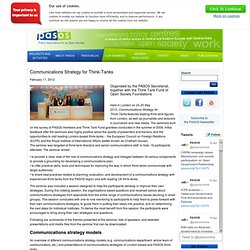

Blog posts for Think Tanks. Blogging for Think Tanks. What even is a blog? Blogging is simple, snappy and straight off the cuff, right?

Wrong. Heavy is the shelf that bears the weight of scrapped attempts to complete an ODI ‘blogging strategy’ and yet the number of ODI blogs and bloggers continues to grow. In a recent blog on From Poverty to Power, Duncan Green discussed why the UN doesn’t have more bloggers. He asked: ‘is blogging an established part of the landscape and is there a successor waiting in the wings?’ , assuming that if blogs are a part of the furniture then everybody should be encouraged to get comfortable with them.
Communications Strategy for Think-Tanks. Communications Strategy for Think-Tanks Organised by the PASOS Secretariat, together with the Think Tank Fund of Open Society Foundations Held in London on 24-25 May 2010, Communications Strategy for Think-Tanks featured leading think-tank figures from London, as well as journalists and lecturers in journalism and new media.

The seminars built on the survey of PASOS members and Think Tank Fund grantees conducted in the summer of 2009. Devaluing the Think Tank. One of the most peculiar, and least understood, features of the Washington policy process is the extraordinary dependence of policymakers on the work of think tanks.

Most Americans — even most of those who follow politics closely — would probably struggle to name a think tank or to explain precisely what a think tank does. Yet over the past half-century, think tanks have come to play a central role in policy development — and even in the surrounding political combat. Over that period, however, the balance between those two functions — policy development and political combat — has been steadily shifting. And with that shift, the work of Washington think tanks has undergone a transformation.